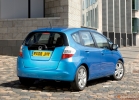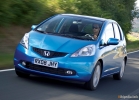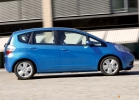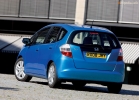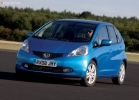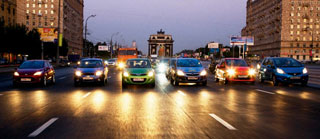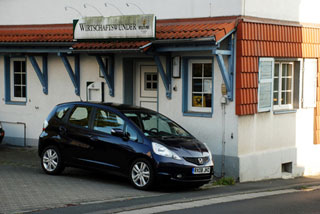Honda Jazz (Fit) test drive since 2008 hatchback
Jazz improvisation
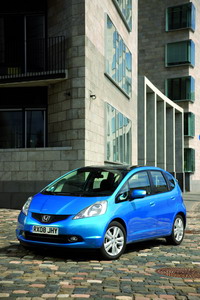 And even this small motor is available high Honda notes, like a virtuoso pipe. He is able to ring, and you move in the rhythm of a swing, characteristic of a big city. Acceleration, rearrangement, braking as a do-Ri metropolitan streets. This compact car travels like by notes that the driver, improvising, puts it in random order, only in accordance with the pace of flows. The second -generation Honda Jazz is a nice, convenient and non -cereal hatchback for a young city dweller or citizen, or a couple of citizens with children. So I thought after a test drive in Frankfurt.
And even this small motor is available high Honda notes, like a virtuoso pipe. He is able to ring, and you move in the rhythm of a swing, characteristic of a big city. Acceleration, rearrangement, braking as a do-Ri metropolitan streets. This compact car travels like by notes that the driver, improvising, puts it in random order, only in accordance with the pace of flows. The second -generation Honda Jazz is a nice, convenient and non -cereal hatchback for a young city dweller or citizen, or a couple of citizens with children. So I thought after a test drive in Frankfurt. Your segment
With a length of 3900 mm, a width of 1695 mm and a height of 1525 mm, the new Honda Jazz occupies a niche between the B-class hatchbacks and compact minivans. It is this type of car that seems to be especially in demand in the era of the crisis. Economic, functionality and environmental friendliness, and also attractive appearance, components of market success.
Even a cursory glance at Jazz is enough for a reason to say about the evolution of the model. In the appearance of the novelty, the features of the past generation are felt, which were noticeably modernized and tightened to new standards of corporate identity. I looked at Jazz, and saw the ghosts of Civic and FR-V. But, damn it, it's not bad! The arrow -shaped design of the front part, a characteristic ledge on the hood, is an expressive bend of the radiator grille. The life -affirming face of Honda Jazz shines with large front headlights spreading on the sides of the front wings. The trapezoidal lower lattice emphasizes the stability of the car for a reason, since the track has become wider (+35 mm in front and +30 mm behind), the wheelbase is longer (+50 mm), the rear wheels arch are more complete. The feed is also very elegant, despite the rather sharp faces and stamping on the fifth door. But decent size the rear lights, again reminiscent of the FR-V LED, which, along with repeators of turns on the side mirrors, add the appearance of charm. In a word, the exterior is quite modern, but at the same time not as avant -garde and sports as, for example, with Accord. And this, perhaps, is correct, since buyers of this kind of machine, as a rule, are rather calm people.
In general, in comparison with the predecessor, the new Jazz has become a little larger. The length increased by 55 mm, width by 20 mm, but the height remained unchanged. This actually increased the stability of the car, which I quickly became convinced, and at the same time did not at all affect its enviable maneuverability. Suffice it to say that the radius of a turn of 9.8 m has remained the same. And this is a serious plus, especially in the native habitat for Jazz in the city.
In addition, I can’t help but note that in the new JAZZ the hardness of the body is significantly increased, which is important not only in terms of safety, but also for better comfort and controllability. It is especially pleasant that now it has become even easier to get into the salon thanks to the wide opening rear door (they open 80 degrees). Let's look inside?
Its a kind of magic
Of course, the Queen group sang about magic of a different kind, but the song was remembered when my colleague and I decided to evaluate the functionality of the car. One of the branded features of the model was the in fact in the center of the body, or rather under the front seats, the fuel tank. Which provided such an additional space in the cabin. In addition, the new JAZZ uses the Magic Seats seats, which has become a popular feature of the previous generation. Since the system was improved, it should be said separately about it.
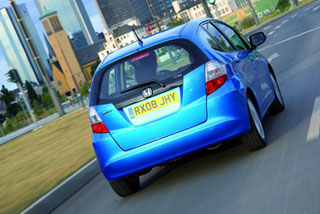 In the new generation of Jazz, the front seats no longer need to be shifted forward in order to provide enough space for folded rear seats. Even if the front seats are most pushed back, the rear with retractable headrests can be easily folded with just one motion, using a special lever. Moreover, Honda even came up with the names for various layouts of the cabin.
In the new generation of Jazz, the front seats no longer need to be shifted forward in order to provide enough space for folded rear seats. Even if the front seats are most pushed back, the rear with retractable headrests can be easily folded with just one motion, using a special lever. Moreover, Honda even came up with the names for various layouts of the cabin. So, in Utility mode, the machine has a perfectly flat floor of the luggage compartment with a maximum length of 1720 mm. This is enough to place three mountain bikes with 26-inch wheels in an upright position inside the car without removing the front wheels. If only most of the rear sofa is lowered, there will be enough space for a surfing board in the luggage compartment if you lay it with the wide side on the floor. In LONG mode, the front passenger seat is completely pushed back, and its back is folded, which allows you to transport items up to 2.4 m long. There are other Tall modes, Refresh, the first allows you to place a high object in the cabin and the second to organize a berth. Well, is it not magic?
In addition, there are at least 10 cup holders on each side of the cabin on each side of the instrument panel, two in the central console in front of the gear lever, two behind the parking brake, and one in each of the door pockets, in curved panels. In the department located in the front console, you can place anything with a drink with a drink, several iPod players, a couple of mobile phones or a box with napkins.
Additional flexibility provides a partition that can be turned 180 degrees in order to change the size of the compartment. Double -haired glove box is also universal. In the upper compartment, a holder for handles and business cards are installed, and in models 1.4 executive there is a valve, when it is opened, the air flow from the climatic installation is opened, which makes it possible to cool or slightly heat the drinks. To the right of the steering wheel, on the instrument panel, there is a small pocket. In the pillow of the left rear seat, a compact department, which can be accessed if the pillow is raised. The compartment opens with the help of two rotary handles, and the operating guide may freely fit in it. In a word, with the placement of all kinds of problems, problems cannot arise. And what about the transportation of people?
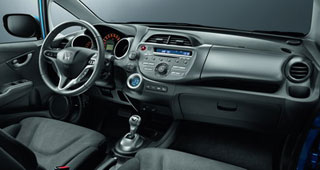 Extraclassic comfort
Extraclassic comfort Naturally, an increase in overall dimensions could not but affect the expanse of passengers. The space for the legs sitting from the back increased by 37 mm, the width of the salon at the shoulders level by 44 mm in front and 43 mm behind. The front seats became 20 mm wider, their lower pillows lengthened by 15 mm and, in addition, became thicker and softer. I appreciated this right away, it was worth sitting behind the wheel. The seat is comfortable, good lateral support is felt, and the adjustment range is quite large. The steering column is also regulated.
The instrument panel is installed low, providing good overview, and contains a combination of three circular shirts: a speedometer in the center, a tachometer on the left, a indicator of fuel level on the right. Constant backlight information is well read with any illumination. In the center of the speedometer, a liquid crystalline display with operational data on instant or average fuel consumption, stocking to the next refueling, temperature overboard, etc. The buttons located on the steering wheel, which migrated to Jazz, allowed the driver to navigate between the information display windows, as well as control with music and cruise control. The controls of the climate control system are located next to the audio system, which provides easy access to them. And in general, the style is somewhat reminiscent of Civic, although there are no noticeable differences. There are no complaints about the quality of finishing materials and accuracy of fitting parts.
Power Plus, consumption minus
In this formula, modern engines are built. Plus, of course, environmental friendliness. Therefore, instead of the I-DSI 2-valve I-DSI, a 4-valve 1.4-liter IVTEC gasoline engine used in previous models of Honda Jazz. It has the same working volume of 1339 cubic meters. cm, but its power has grown from 83 to 100 hp, and the value of torque increased to 127 nm. This motor can be aggregated with an advanced version of a 5-speed mechanical KP, and with a 6-speed automated I-SHIFT mechanical transmission. Moreover, the models with I-SHIFT are equipped with a mountain start system (Hill Start Assist, HSA), which continues to hold the brakes in the position for several seconds until the driver moves the leg from the brake pedal to the gas pedal, thus preventing it, thus, thus preventing it rollback. But the first version with the manual transmission came into my hands.
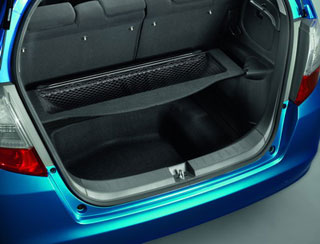 I start the engine. You can understand that he earned, only at the tachometer arrow is quietly inside, no vibrations. I squeeze the not too long -term and rather soft clutch pedal and on the way. Hooray! Finally, a function appeared in the Japanese car when one light touch to the turn of the turn indicator is enough for it to blink three times. But I will not be distracted.
I start the engine. You can understand that he earned, only at the tachometer arrow is quietly inside, no vibrations. I squeeze the not too long -term and rather soft clutch pedal and on the way. Hooray! Finally, a function appeared in the Japanese car when one light touch to the turn of the turn indicator is enough for it to blink three times. But I will not be distracted. The increase in power is noticeable immediately. Acceleration is quite confident and rather frisky, especially in the first, second and third programs. Moreover, switching from one stage to another is easy due to the clear course of the μP lever. Only now, the clutch pedal could be more in formatively, the moment of picking up is not clearly traced. But the engine is elastic. Of course, according to the tradition of Honda, he demonstrates his true potential after 3,500 rpm, but we also notice the supply of traction to this mark under the right foot. This, by the way, will help in traffic jams where it is possible, as in a machine, move in second gear, not particularly bothering yourself with frequent switching. True, an additional pointer appeared on the instrument shield, which tells us when it is better to switch to the next step to ensure the maximum possible fuel savings. Probably, this will help someone, and the indicator annoyed me. Especially when I decided to grab on winding paths near Frankfurt.
After 2500 rpm, the yellow arrow urgently advised me to go a step higher, but it did not suit me in front of a bunch of good turns, which will only include an Estonian pensioner at the idle speed. The turn of the lamb and immediately note that the steering, despite the electric power, became noticeably more informative. In addition, with an increase in speed, the force increases, and the reaction of the machine is clear and fast (here is a plus of increased body hardness). But Jazz is not Civic, and not Accord. His pendants were tuned more on a comfortable and safe ride than on an incendiary drive. The body tilted a bit, but, nevertheless, the car clearly follows the trajectory I have chosen, except that the nose is slightly turning at at the very beginning of the turn. If you completely overdo it with speed, then the stabilization system will turn on. If you turn it off, the demolition of the front axle will begin. Yes, and under the discharge of gas JAZZ, it is not at all to strive to hang the tail, which again speaks of safe suspension settings.
However, even if this car is not too suitable for racing not for racers, it was created. The main thing is that engineers significantly improved the smoothness of the course, which could not be given the proper on the autobahn. Know yourself wound hundreds of kilometers in silence and without unnecessary stress. Unless the sharp impulses of the side
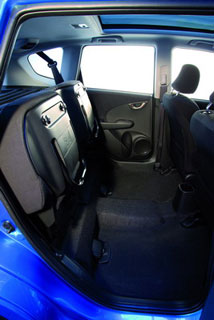 winds may require a slight correction of the course by the steering wheel affects the relative lightness of the body and its decent height. But you can painlessly and quite quickly gain cruising 120-140 km/h, and feel quite confident. Jazz is able to keep the way. And if you need to stop quickly: the brakes are powerful, the ABS and the system of distribution of brake forces are equipped, and the pedal force is dosed well. And, of course, all this can be said about the version with the I-SHIFT robot.
winds may require a slight correction of the course by the steering wheel affects the relative lightness of the body and its decent height. But you can painlessly and quite quickly gain cruising 120-140 km/h, and feel quite confident. Jazz is able to keep the way. And if you need to stop quickly: the brakes are powerful, the ABS and the system of distribution of brake forces are equipped, and the pedal force is dosed well. And, of course, all this can be said about the version with the I-SHIFT robot. I met this modification a day later, and I think that the girls might like it. Because there is no clutch pedal, and transmission can switch in fully automatic mode. True, you should be prepared for noticeable grades when switching from one step to another, especially at high speeds. But this is the trouble of all such mechanisms. Although it is felt that the engineers tried very hard to minimize the switching time. The robot can also be controlled manually, which can significantly improve the smoothness of the move only with every push of the μP lever slightly discard the gas, imitating the clutch. When you achieve complete understanding of the jerking will disappear altogether. In addition, the same HSA system works fine, and in the conditions of the city crowd I-SHIFT it is quite convenient.
We are waiting for the price
There is no doubt about the demand for the new Jazz. How popular it will be, of course, depends on the price. But just the price for the Russian market has not yet been determined: Jazz will have only in May.
However, Honda in Russia demonstrates amazing, especially in today's times, successes. So there is no doubt in the success of the novelty. None of the foreign brands showed such a sales growth. True, Jazz will have to compete with Nissan Note, Mitsubishi Colt, Toyota Auris and Ford Fiesta. A good company, and in it Jazz will find its place.
Andrey Osipov
Frankfurt Moscow
Photo Honda
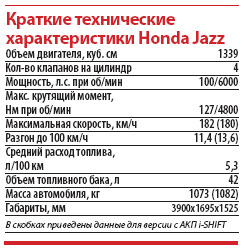
Honda Jazz (FIT) Video Video since 2008
Honda Jazz (FIT) Krash Test Video since 2008
Honda Jazz (Fit) test drive since 2008
Honda Jazz (Fit) Krash Test since 2008
Krassh Test: Detailed Information78%
Driver and passengers
60%
Pedestrians
79%
Children-passengers
71%
Active security system

